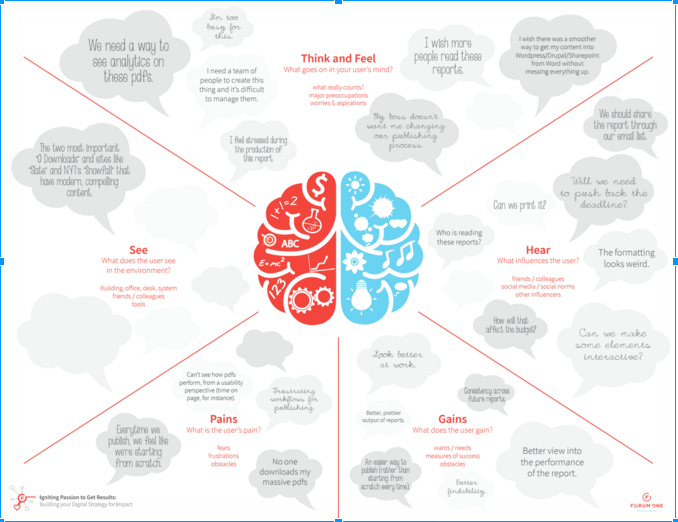Blog Insights
Mapping Content to Audiences – Part 2

In Part 1, I walked through some hard truths about what we publish online: people engage with content they find valuable.
But how do we figure out what will resonate with our key audiences?
The good news is, there are lots of ways to tackle this. People may not always be great at knowing what they want, but they are amazing at knowing the challenges they face everyday. They know what they’re afraid of. They know what their hopes and dreams are.
And this is exactly where we begin: Audience discovery.
The Ideal Situation
Editors, marketers, advertisers, user experience designers, ethnographers—we’ve been researching audiences for as long as we’ve been creating things for others. There’s no shortage of ways to research the wants, needs, and behaviors of our audiences.
In a world where we have unlimited budget, a flexible timeline, and the right people with the right amount of time, this is the right way to approach audience discovery.
There are a number of tried-and-true methods for audience research, including:
- Observational research – the researcher embeds herself in “the field,” the natural environment for the target audience or user. The situation is important – if, for instance, the researcher is aiming to understand the experience for Seattle bus-riders, she would spend hours riding different buses, taking notes on all observations. At the end of the study, the researcher is well armed with insights about the experience and can draw some conclusions.
- Audience interviews – the researcher interviews individual representatives of target audiences one on one. Through a series of targeted questions, the researcher works through the interview and, in the end, has a self-reported portrait of that audience, through the eyes of a single member. When repeated, a more robust picture forms.
- Usability studies – the researcher writes a script of “scenarios” or tasks to be performed and observes targeted users’ performance on said tasks. The user is not being tested–the product is–but through this process, the researcher gains an understanding on how the user interacts with the product, giving her insight into frustrations, expectations, etc.
This is a small taste – there are many other methods for effectively researching audiences.
Many (myself included) will argue that no matter how small your budget, there should always be room for research. But it tends to be pushed aside, de-prioritized in favor of more design, more features, more stuff.
So idealism aside, what’s the next best thing to research?
The Empathy Approach
In the absence of extensive audience research, prioritize empathy.
Now, bear with me; empathy is becoming an ugly buzzword, often coupled with blanket statements and abstract proclamations — difficult to put to use. That’s not the empathy I mean. Instead, we can take a 3-pronged, empathy-fueled approach to getting into our audiences’ heads. This allows us to create content that’s considering our audiences first, not our own needs (which will ultimately fulfill our needs, as well).
The Process
Step 1 – The Empathy Map
Empathy maps are a common tool for marketers and user experience designers. While they may all look a little different, ultimately, an empathy map is a diagram of what an individual audience member might be seeing, feeling, thinking, and hearing on any average day, along with some exploration of “pains” (obstacles faced, fears, failures) and “gains” (successes, hopes and dreams, happy moments).
For us, it looks a little like this:

Here are the components of Step 1:
- Draw out (or print out) a blank empathy map, and write down your audience member in the middle.
- Take a moment and try to picture a day in the life of this person. Fill in thoughts as they come, in the appropriate areas.
- Invite other team members to participate as well – the more input we have on these, the better.
The obvious limitation of this approach is that it is based on assumptions. Keep in mind, this “best guess” approach is for when audience research has been pushed by the wayside.
If audience research is available, use observations from the research to fill in the empathy map.
Limit each empathy map to one audience type. The more specific, the better.
Step 2 – Finding Insights
Once the empathy map is filled out, it is time to focus in on the pains and gains, and understand what they mean for us.
- Separately list out the pains, while keeping the map visible. The map will be a reference from here on out.
- For each pain and gain, list out a few ways each one manifests itself in the person’s life.
- e.g. if we’ve discovered that our 17-year-old high school student is afraid of being alone and disconnected, explore ways she works to combat that or how it affects her relationships, etc.
- Repeat for each pain and gain.
- For one pain or gain, create a statement that couples an “insight” with it. Make that statement like a user story, in that it’s told from the audience member’s point of view.
- e.g. “As a 30 year old man working 70 hours a week, I want to be taken seriously for the work I do and all that time I put in, but I’m afraid I am constantly passed over for promotions.”
- Note that these statements are often structured, user + need + insight / contradiction / cause. So, As a ________, I need to ________, [but / because / however / instead / even though / and / except] _____________.
Don’t settle for the first statement produced – writing these in a powerful, effective way takes time and practice. They are deceptively difficult to get right, so keep writing.
The goal of this step is to understand what is fueling your audience’s needs, hopes, and fears – and to set us up to develop content that can help address those things in a positive, valuable way.
Step 3 – Find Your Insights
Once we have a statement (or a few – the more, the better), we’re in a great position to figure out what content our audience is likely to find appealing.
- Focus on the statement produced in Step 3.
- Ask the question — “what content can help address this statement?” List 10 ideas for each. Consider “phantom audiences,” too — additional audiences that may be implied by the statement.
For example, in the statement above, I might list out the following content:
- interviews from successful men in similar situations, over several industries, with advice
- consider blog articles, podcasts, videos
- assertive, image-based affirmation campaign on Instagram
- stories about successful promotion strategies
- career planning guides / checklists
- webinar about resume building
And the list could go on for days. Based on the statement we generated, we are now aware that job performance confidence is a key motivator for stress in this audience’s life. We are then empowered to respond accordingly with valuable content that addresses this key motivator.
Research Supports Empathy, Empathy Supports Research
This framework can be extremely powerful for your content strategy, but it relies heavily on a couple of assumptions. First, it assumes that your target audiences have been correctly identified. For instance, if you expect new moms to be really into your new 3-day adventure camp excursion in Fiji, you’re probably going to struggle with these exercises.
Finally, this framework assumes you’re in a genuine position to empathize with your audiences. But I can’t stress enough — research is always better than assumption. Research makes the empathy more accurate. If you’re a 42-year-old white male in a 6-figure marketing position, and you’re making assumptions about 16-year old Chinese high school students, you’re doing it wrong.
Remember, your content strategy should solve your audience’s needs first, so just think, research, plan, and most importantly, empathize. Your needs should (and will) follow.
For more on mapping content to audiences, revisit “Part 1: Setting the Foundation. Sticking to the Point.”